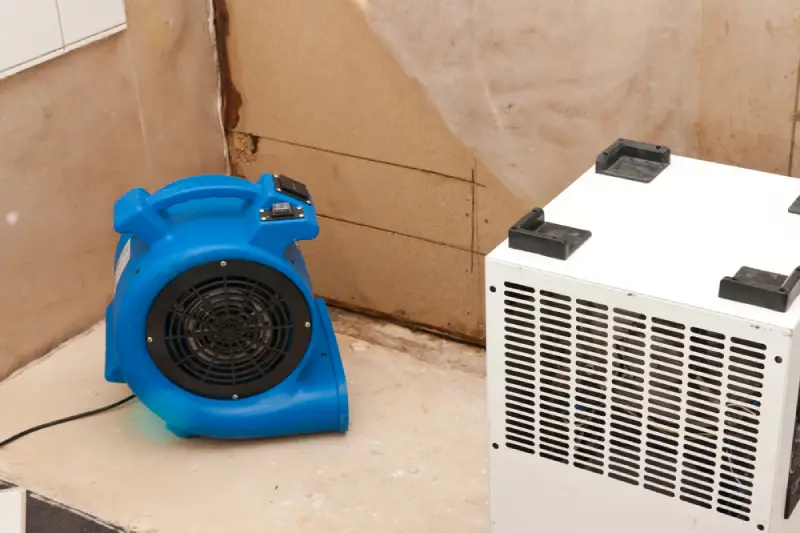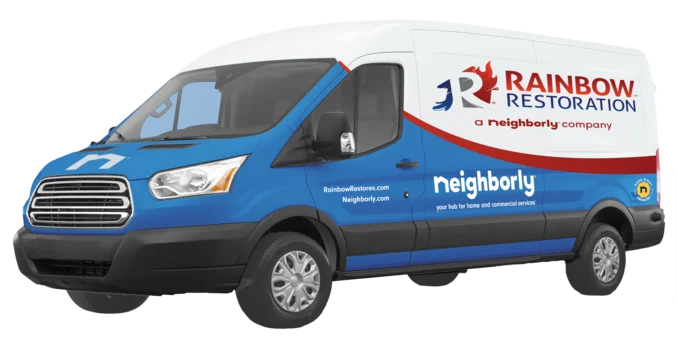
Rainbow Restoration experts highlight the following ways flooding can cause extensive damage to homes and businesses:
|
Thunderstorms, tropical storms, hurricanes, excessive rain, and snow are all commonly recognized causes of floods. But did you know flooding also occurs due to overburdened or clogged sewage and drainage systems, urbanization efforts, dam failures, and other causes? Flooding can happen quickly or gradually, affecting both obvious flood zones and areas that appear safe during dry weather.
According to FEMA, water damage from floods is one of the most common and costly hazards in the U.S. In fact, research by the NFIP (National Flood Insurance Program) indicates a 26% chance of flooding in high-risk areas over the course of the average 30-year mortgage.
This guide explores the ways flooding can impact homes and businesses, including what damage can be done by floods, potential causes, and flood damage restoration solutions to help property owners recover quickly.
How Can Floods Affect a Home or Business?
Floods can have devastating effects on homes and businesses, causing structural damage, destroying personal property and inventory, and creating health hazards from mold and contaminated water. Here are five of the most common effects of flood damage to homes and businesses:
1. Structural damage to walls, floors, and foundations
One of the most severe risks of flood damage is the impact on a building's structural integrity. Prolonged exposure to moisture can cause wood to rot, concrete to erode, and foundations to shift. These situations weaken the very framework of the property, potentially leading to costly repairs.
If a structure has been affected by flooding, prompt intervention by a professional water damage restoration team is essential to assess and mitigate further harm to the building.
2. Health risks from mold growth
Floodwaters provide an ideal environment for mold to thrive. Spores can begin to multiply within 24–48 hours of moisture exposure, leading to unpleasant odors, unsightly growths, and health concerns.
Mold can trigger allergic reactions, respiratory problems, and other illnesses, particularly in individuals with weakened immune systems. A swift response from an experienced flood damage restoration company is necessary to remove the moisture and thoroughly clean affected areas, preventing mold from spreading and minimizing potential health risks.
3. Electrical hazards
An often-overlooked risk of flooding is the damage it can inflict on a building’s electrical system. Water that seeps into electrical panels, outlets, and wiring can cause short circuits and create fire hazards. Waterlogged electrical systems are also prone to corrosion, which can compromise their safety and functionality over time.
4. Damage to personal belongings and inventory
Furniture, electronics, and business documents can be severely damaged when submerged in floodwater. Personal belongings that hold sentimental value can also be affected, causing emotional distress. For businesses, the loss of inventory can significantly impact revenue.
Commercial and residential contents restoration services include recovering, cleaning, and storing items after a flood. A professional flood damage restoration company will restore damaged items to their best possible condition.
5. Repair and restoration costs
Flood damage can cause significant repair and restoration costs for homeowners and businesses. Not only can inventory and personal belongings be damaged, but building structures can also be compromised.
The longer flood damage goes unaddressed, the higher the cost of repairs and restoration. Immediate action is crucial to reduce further damage, such as rot, rust, or structural failure.
A professional restoration team can efficiently assess the damage, implement immediate measures to prevent additional harm, and initiate comprehensive repairs to restore the property to its best possible condition.
Sources of Flood Damage
Property owners should be aware of other potential sources of flooding that can occur even outside of recognized flood zones:
Extreme weather
Climate change has increased the frequency and intensity of extreme weather events. Heavy rainfall, hurricanes, and rapid snowmelt can lead to flash floods and widespread riverine flooding. Here are some of the key ways extreme weather contributes to flood damage:
- Intense rainfall: A large amount of rain falling in a short period can overwhelm even well-maintained drainage systems. This rapid accumulation of water leads to flash flooding, where streets, basements, and low-lying areas are inundated with little to no warning.
- Hurricanes and tropical storms: These storms bring not only torrential rain but also a phenomenon called "storm surge." This is a massive rise in sea level caused by the storm's powerful winds and low atmospheric pressure. Storm surge can inundate coastal communities, causing catastrophic flooding and damage far from the storm's eye.
- Rapid snowmelt: When a heavy snowpack melts quickly, often due to a sudden rise in temperature or heavy spring rain, the resulting runoff can be immense. This can cause rivers and streams to overflow their banks, leading to widespread flooding.
Overburdened infrastructure
Sewage and drainage systems are designed to handle a specific capacity. If overburdened or blocked, they can become overwhelmed by even moderate rainfall, causing water to back up and flood streets, basements, and other low-lying areas.
This issue is often compounded by debris, such as leaves, plastic waste, and other trash, that clog grates and pipes, preventing water from draining properly. It's a localized problem that can have widespread effects, especially in older cities with aging infrastructure.
Land use changes
Urbanization—the development of cities and the conversion of natural landscapes into built-up areas—drastically changes how water behaves.
Forests and grasslands act like sponges, absorbing rainfall and allowing it to seep slowly into the ground. When these areas are covered with impervious surfaces, such as concrete, asphalt, and rooftops, the water has nowhere to go, creating rapid runoff that overwhelms drainage systems and streams.
The result is urban flooding, a direct consequence of altering the natural flow of water. Even a brief, intense downpour can cause significant flooding in a heavily developed area.
Dam failures
While dams are built to control water flow and provide resources like hydroelectric power and irrigation, a structural failure can release a massive, destructive surge of water.
While rare, dam failure can occur due to a natural disaster, such as an earthquake or extreme rainfall event, that puts immense pressure on the structure. The result is typically a catastrophic flash flood, capable of wiping out entire communities downstream with little to no warning.
Have You Suffered Water Damage at Your Home or Business?
In the event of flood damage to homes and businesses, time is not on your side. Property damage and loss from seeping water require fast action. Losses due to flood damage are not typically covered under a standard homeowner’s insurance policy. However, when water or storm damage occurs, Rainbow Restoration® is there to help.
Rainbow Restoration professionals provide trusted residential and commercial water damage restoration in locations throughout the United States and Canada. Get a speedy resolution: Call for 24/7 emergency service.
This article is intended for general informational purposes only and may not be applicable to every situation. You are responsible for determining the proper course of action for your home and property. Rainbow Restoration is not responsible for any damages that occur as a result of this blog content or your actions. For the most accurate guidance, call the Rainbow Restoration location nearest you for a comprehensive, on-site assessment.
Flood Damage Restoration FAQ
Setting the highest standards in water, fire, and mold damage restoration requires a continuous dedication to education and improvement. This commitment to exceptional service also includes using our years of experience and expertise to answer your restoration questions. Here are answers to some of the most frequently asked questions about flood damage.
What damage can be done by floods?
Floods can cause widespread destruction beyond just waterlogged property, and immediate damage can worsen if not addressed promptly. Common types of flood damage can include:
- Structural damage: The immense force and pressure of floodwaters can compromise a building's foundation, walls, and floors, leading to cracks, instability, and even collapse.
- Contamination and health risks: Floodwater is often a toxic cocktail of raw sewage, chemicals, and other hazardous materials. Contaminated water not only ruins belongings but also leaves behind bacteria and mold that can cause illness.
- Electrical and mechanical failures: Electrical systems, wiring, HVAC units, and appliances are quickly destroyed by water, creating fire hazards and expensive replacement costs.
- Inventory and property loss: Floods can wipe out a business’s valuable inventory, equipment, and critical data, while homeowners lose irreplaceable personal belongings and cherished possessions.
- Mold growth: Standing water promotes the growth of mold within 24–48 hours, which can infest porous materials and cause respiratory problems and allergic reactions.
Why is a professional water damage restoration service necessary for flood cleanup?
Restoration services have the specialized equipment and training to effectively mitigate water damage. Rainbow Restoration professionals use industrial-grade water extractors, dehumidifiers, and air movers to dry a property thoroughly.
Our process, known as rapid structural drying, prevents secondary damage like mold growth and warping of materials. Our service professionals also have the expertise to identify hidden moisture and can handle any contaminants present in the floodwater.
How can a business benefit from professional flood damage restoration services?
Businesses in flood zones are at risk of catastrophic property and revenue loss. Rainbow Restoration offers a rapid response to commercial flood events, helping to minimize business disruption.
Rainbow Restoration’s large-loss capabilities enable us to handle extensive damage in commercial properties. We work to quickly restore the business to its best possible state, addressing everything from structural damage to loss of equipment and inventory.
